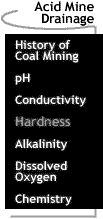

 |
Acid Mine Drainage: Hardness Water hardness is the total
concentration of cations, specifically calcium (Ca2+),
magnesium (Mg2+), iron (Fe2+) and manganese (Mn2+) in water. Photo: Courtesy of Kenneth E. Rastall Water hardness is the total
concentration of cations, specifically calcium (Ca2+),
magnesium (Mg2+), iron (Fe2+) and manganese (Mn2+) in water. Photo: Courtesy of Kenneth E. RastallA stream's hardness reflects the geology of the catchment area and sometimes provides a measure of the influence of human activity in a watershed. For instance, acid mine drainage often releases iron (Fe2+) into a stream, resulting in extraordinarily high hardness readings. For this reason, hardness is a useful water quality indicator. For the most part, however, hardness is a measure of the calcium and magnesium that enters the stream through the weathering of rock. In the Wheeling Creek watershed, the bedrock is mostly limestone. Limestone is calcium carbonate, or CaCO3. When limestone weathers, it dissolves into calcium (Ca2+) and carbonate (CO32-). Calcium is an important nutrient used by plants and animals as it moves downstream. Carbonate enters the carbonate buffering system described under alkalinity. [ Acid
Mine Drainage: History of Coal Mining /
pH /
Conductivity / [ Sewage ] [ Agriculture ] [ Dredging ] [ Home ] [ Teacher Pages ] [ Modules & Activities ] |
HTML code by Chris Kreger
Maintained by ETE Team
Last updated November 10, 2004
Some images © 2004 www.clipart.com
Privacy Statement and Copyright © 1997-2004 by Wheeling Jesuit University/NASA-supported Classroom of the Future. All rights reserved.
Center for Educational Technologies, Circuit Board/Apple graphic logo, and COTF Classroom of the Future logo are registered trademarks of Wheeling Jesuit University.